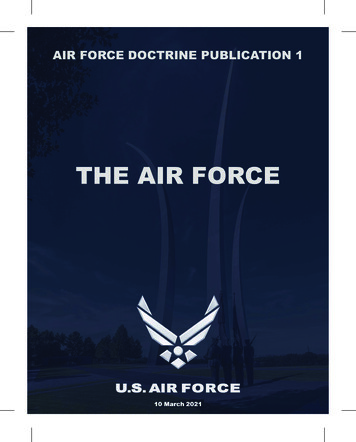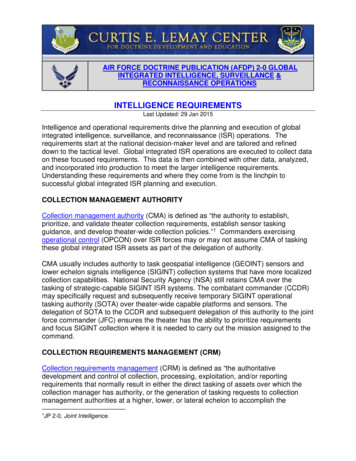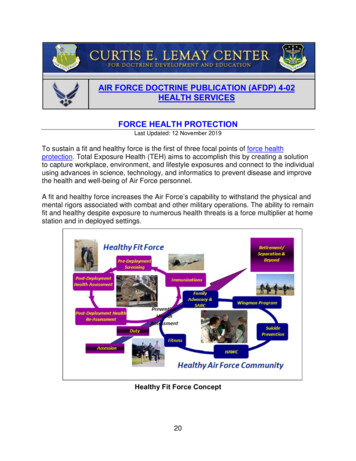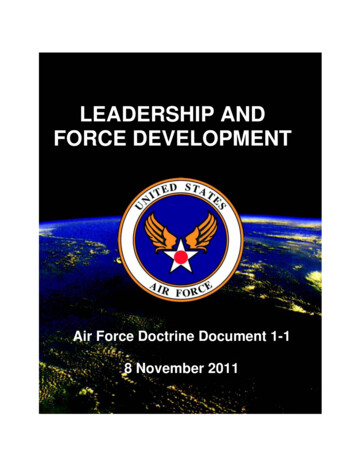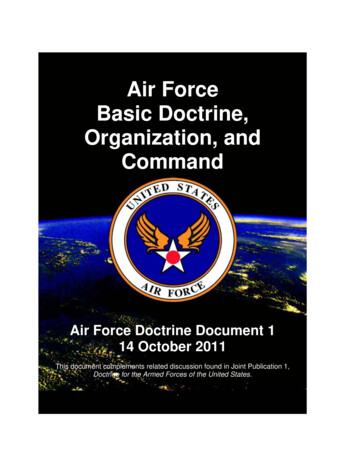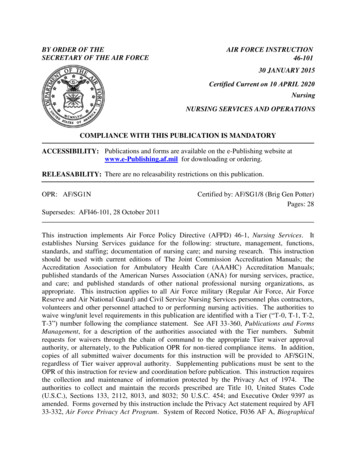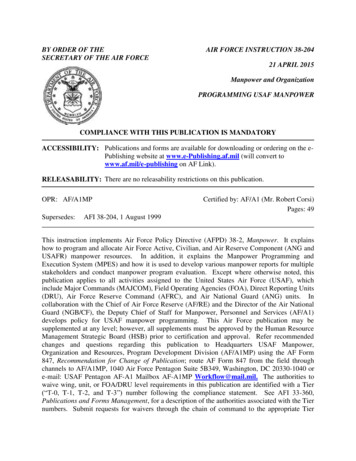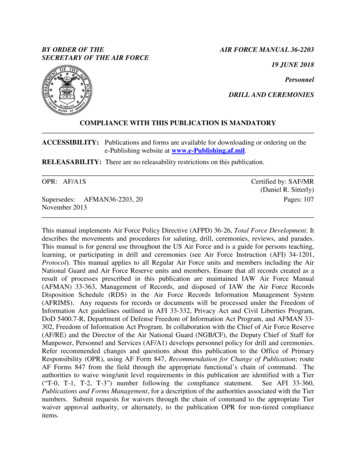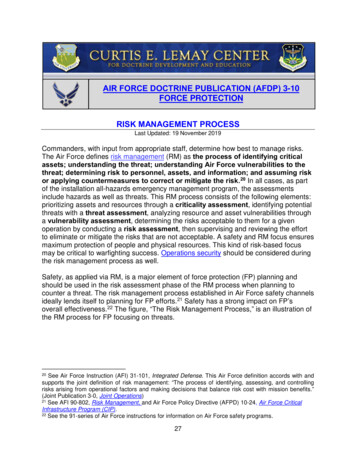
Transcription
AIR FORCE DOCTRINE PUBLICATION (AFDP) 3-10FORCE PROTECTIONRISK MANAGEMENT PROCESSLast Updated: 19 November 2019Commanders, with input from appropriate staff, determine how best to manage risks.The Air Force defines risk management (RM) as the process of identifying criticalassets; understanding the threat; understanding Air Force vulnerabilities to thethreat; determining risk to personnel, assets, and information; and assuming riskor applying countermeasures to correct or mitigate the risk. 20 In all cases, as partof the installation all-hazards emergency management program, the assessmentsinclude hazards as well as threats. This RM process consists of the following elements:prioritizing assets and resources through a criticality assessment, identifying potentialthreats with a threat assessment, analyzing resource and asset vulnerabilities througha vulnerability assessment, determining the risks acceptable to them for a givenoperation by conducting a risk assessment, then supervising and reviewing the effortto eliminate or mitigate the risks that are not acceptable. A safety and RM focus ensuresmaximum protection of people and physical resources. This kind of risk-based focusmay be critical to warfighting success. Operations security should be considered duringthe risk management process as well.Safety, as applied via RM, is a major element of force protection (FP) planning andshould be used in the risk assessment phase of the RM process when planning tocounter a threat. The risk management process established in Air Force safety channelsideally lends itself to planning for FP efforts. 21 Safety has a strong impact on FP’soverall effectiveness.22 The figure, “The Risk Management Process,” is an illustration ofthe RM process for FP focusing on threats.20See Air Force Instruction (AFI) 31-101, Integrated Defense. This Air Force definition accords with andsupports the joint definition of risk management: “The process of identifying, assessing, and controllingrisks arising from operational factors and making decisions that balance risk cost with mission benefits.”(Joint Publication 3-0, Joint Operations)21 See AFI 90-802, Risk Management, and Air Force Policy Directive (AFPD) 10-24, Air Force CriticalInfrastructure Program (CIP).22 See the 91-series of Air Force instructions for information on Air Force safety programs.27
The Risk Management Process(Derived from AFI 31-101, Integrated Defense)CRITICALITY ASSESSMENTA commander should understand and identify those assets critical to missionexecution. A criticality assessment is a systematic effort to identify key assets andinfrastructure and evaluate the effect of temporary or permanent loss of the same on aninstallation’s or a unit's ability to perform its mission. This assessment should examinecosts of recovery and reconstitution including time, funds, capability, and infrastructuresupport. Assessments of non-mission essential assets should also be considered, suchas high-population facilities; mass gathering activities; and other facilities, equipment,services, or resources deemed important by the commander to ensure continuedeffective operation. This assessment also assists the commander in identifying assetsthat are priorities for FP resource allocation.The criticality assessment identifies the relative criticality of assets based on missioncriticality, impact on national defense, replaceability, and monetary value. An asset isanything of value, including people, information, equipment, facilities, and infrastructure.Assets can also extend to more general or intangible items such as operations,systems, strategic advantage, morale, and reputation. The primary objectives in theeffective asset criticality assessment are to identify key assets, determine if criticalfunctions can be duplicated, identify the resources required for duplication, anddetermine the priority of response.28
Assessing criticality requires judgment and analysis. For example, the enemy’sdestruction of an asset not considered essential to mission success or necessary forcontinued efficient operations may still be critical, if the enemy perceives it to besymbolic. Such an asset may warrant protection because its loss may give an enemythe media coverage they seek or cause personnel to doubt a commander's ability tokeep them safe. Complete protection of every asset is not possible, but the moredifficult it is for the enemy to attack an asset, the less likely they are to attack. Thecritical asset risk management program enhances the risk management decisionmaking capability at all levels to ensure that Air Force critical assets are available whenrequired to support mission requirements in an all-threats and hazards environment.This risk management approach supports the prioritization of scarce resources acrossthe Air Force, focusing priorities on the greatest risk based on assessed criticality,threat, vulnerability, and risk.THREAT ASSESSMENTA commander should know what threat is anticipated in order to devise aneffective means to counter or mitigate it. Without this knowledge, the commander isacting blindly. A thorough threat assessment reviews the factors of a threat’s existence,capability, intention, history, and targeting, as well as the operating environment withinwhich friendly forces operate. Analyzing and synthesizing this information are essentialprecursor steps in identifying the probability of attack. Air Force Office of SpecialInvestigations (AFOSI) and other Service counterparts produce a local threatassessment that should be used as a baseline product for adversary threats in the FPeffort. At the installation level, the threat working group or other intelligence fusion andanalysis cell (e.g., a joint intelligence support element) should assist in producing alocalized threat assessment and recommend courses of action to the commander tomitigate or counter threats.In the complex environment of irregular warfare (IW), intelligence, surveillance, andreconnaissance (ISR) forces should use information collected from a variety of sourcesto provide or collect information to fill intelligence gaps. ISR personnel should validatethe credibility of these various sources to overcome adversary denial, deception, andinformation operations. Though rules of engagement and operational objectives driveoperations, analysts should craft their intelligence requirements to help protect thepopulation against both lethal and nonlethal capabilities. Analysts should recognize anincreased need to make correlations between various development projects and levelsof cooperation with the local nationals. Additionally, ISR forces should be aware thatone of the basic underpinnings of successful IW operations is the capability to trainpartners to conduct independent operations and participate in coalition operations.Threat assessments fuse information and intelligence from open source, lawenforcement, government intelligence, medical intelligence, and counterintelligenceinformation, along with local, state, and federal information to create a cohesive threatpicture for FP decision-makers. By synthesizing law enforcement, intelligence, medicalintelligence, and counterintelligence information, analysts can identify indicators of29
future attacks. The more common sources are described in the figure, “Sources ofIntelligence and Counterintelligence.”OPEN SOURCE INFORMATION:—News media, hearings, publications, reference services, publicly availableinternet sites/dataLAW ENFORCEMENT INFORMATION:—Collection, retention, and dissemination regulated by law enforcementchannels—Law enforcement informationGOVERNMENT INTELLIGENCE AND COUNTERINTELLIGENCEINFORMATION:—Products and reporting from the US intelligence communityLOCAL, STATE, AND FEDERAL INFORMATION (including host nation):—Service member, civil servant, individuals with regional knowledge—Counterintelligence force protection operations—information gleaned fromthe streetsSources of Intelligence and Counterintelligence.Considering the wide range of possible threats, FP personnel should focus ondeveloping a robust force protection intelligence (FPI) threat picture to support unitdeployments, readiness training, mission planning, and other mission executionfunctions such as integrated defense, the critical infrastructure program, and emergencymanagement. 23 Commanders should develop priority intelligence requirements to guideFPI work supporting their decision-making and operations. FP personnel shouldcoordinate with their cross-functional counterparts to ensure information requirementsare satisfied. Once FP information has been fused, the end product should be providedto the commander to guide intelligence-driven and risk-based measures or operations,such as counterintelligence support to FP, to preempt, deter, mitigate, or negate threats.FPI provides support to all phases of FP operations.The AFOSI’s local threat assessment is a good starting point for general information onthe security threats facing an installation. However, when more specific local threatinformation is required, it can be obtained from multiple sources through AFOSI’s liaisonwith federal, state, local, and foreign national law enforcement, counterintelligence, andsecurity agencies. 2423See AFI 31-101; AFPD 10-24; and AFI 10-2501, Air Force Emergency Management Program, for moreinformation on these functions.24 AFPD 71-1, Criminal Investigations and Counterintelligence.30
VULNERABILITY ASSESSMENTOnce the threat assessment is complete, commanders should prepare a vulnerabilityassessment of their personnel, equipment, facilities, installations, and operating areas.This assessment should address the broad range of medical and physical threats to thesecurity of the commander’s personnel and assets. The vulnerability assessment thenconsiders the identified and projected threats against personnel, facilities, or otherassets to identify those areas where resources are susceptible to actions which mayreduce or diminish operational effectiveness. This includes the local populace andinfrastructure due to association or proximity with Air Force operations.Airmen should consider both the threat and existing vulnerabilities, but should not relyexclusively on the assessed threat. For example, terrorists successfully attacked militarytargets, such as Khobar Towers, the USS Cole, and three residential compounds inRiyadh, Saudi Arabia, even though those locations were in force protection conditionBravo. Non-military targets, such as the US embassies in Tanzania and Kenya or theWorld Trade Center, have been attacked when the country terrorist threat assessmentsfor those locations were moderate, low, or negligible. History shows that the assessedthreat is not necessarily an accurate reflection of the actual threat. As a result,identifying vulnerabilities is critical. Once identified, steps to mitigate the vulnerabilitiesshould be undertaken to increase survivability for Air Force personnel and assets.RISK ASSESSMENTThe risk assessment compares the relative impact of any loss or damage to an asset(criticality) with the relative probability of an unwanted event. When combined in aquantified fashion, these elements analyze and measure the risks associated with anunwanted event. Upon completion of the criticality, threat, and vulnerabilityassessments, commanders should have the information they need to make decisionsregarding what level of risk they are willing to accept. However, risks to the most criticalAir Force assets should be mitigated or eliminated whenever possible. If risks cannot beeliminated, commanders should implement measures to mitigate them to the greatestextent possible.31
the risk management process as well. Safety, as applied via RM, is a major element of force protection (FP) planning and should be used in the risk assessment phase of the RM process when planning to counter a threat. The risk management process established in Air Force safety channels ideally lends itself to planning for FP efforts. 21
